Home
> Scales
> Phrasing
This lesson should come after the series on soloing over chords. Once you've established which scale you're playing, it's time to work on creating meaningful movements within that scale, experimenting with different tone combinations and target notes. This lesson will help break that process down for you.
Video lesson (from the YouTube Channel)
When you first learn scales, you'll most likely be playing them in a linear sequence, from the 1st to 7th note and vice versa. This is fine for getting to know the scale's pattern on the fretboard and its general flavour, but you'll eventually want to highlight the scale's unique sound more effectively. That's where scale phrasing comes in.
If you're playing over a major chord, the "safest" tones to start and end on are the major triad tones - root (1), 3rd (3) and 5th (5). Pulled from a common major scale pattern, they would appear as follows...
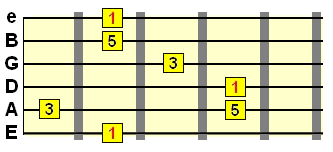
Remember, all major scales (mixolydian, lydian, phrygian dominant etc.) share those core triad tones, which is why they are considered safe reference points in these initial stages.
If playing over a minor chord, the minor triad tones - root (1), minor 3rd (b3) and 5th (5) - will provide a similar reference point for starting and ending your phrases. Again, if we pull these tones from a typical minor scale pattern, here's how it looks...
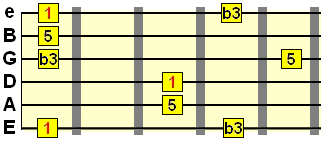
When learning scales and their patterns, you'll be able to identify these triad tones more and more easily, as they are shared across all scales you'll learn, so you don't have to keep memorising them from scratch.
These starting/ending notes will typically be held on to (emphasised) longer than the notes in between them.
The main thing is that you don't simply rely on linear movements, e.g. 1 2 3 4 5 6 5 4 3 2 1 etc. Instead, try jumping around the scale, skipping strings and intervals, moving up and down the scale etc.
The more varied your movements, the more phrasing options you'll have to build on.
Here's an example of a short phrase from the C major scale, using the root and 3rd as starting/ending notes.
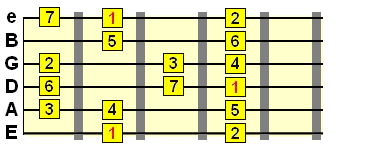
We could also repeat the root and 3rd within a phrase if we wanted...
By using those safe starting and ending notes we can put our scale phrases into context.
Here's some phrasing examples using a minor scale, Dorian...
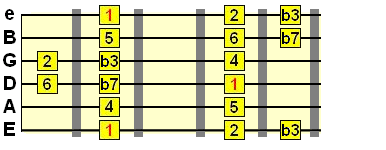
The first phrase (from C Dorian) uses the minor 3rd (b3) tone as the ending note. As we learned earlier, the b3 is part of the minor triad, and so is a safe choice for holding onto...
However, ending a phrase on the 6th will really bring out that Dorian flavour. This tone can be held safely over the minor chord, even though it has that tense quality...
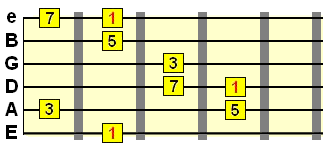
Try blending these arpeggio movements into larger scale phrases, using the arpeggio as the scaffolding of your phrase.
If we were soloing using a minor scale, we'd pick out the minor triad tones for a minor arpeggio based phrase...


If we're playing a major scale, simply use the major pentatonic tones from within the pattern - 1 2 3 5 6...
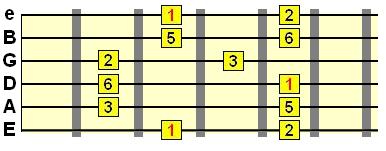
And for minor scale soloing, structure your phrases around the minor pentatonic tones - 1 b3 4 5 b7...
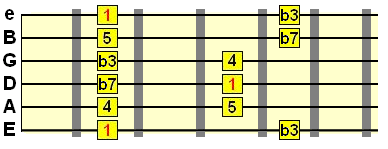
These are just the basics, but there should be nothing stopping you from using the scales you learn to experiment with phrasing. The more you play around with different sequences from a scale, the more your ear is trained to pick out expressive movements. By fully exploring the scale using techniques such as string skipping, runs, arpeggios around those safe starting and ending notes, you avoid falling into the trap of simply plodding along aimlessly. Your phrases need that destination to put them into context.
Anyway there's a lot to think about! Take your time.
Scale Phrasing - Chromaticism & Passing Tones
More Guitar Scales Lessons
More Lead Guitar Lessons
Guitar Scale Phrasing - The Basics
When you learn a scale on guitar, it's important to know how to turn that linear pattern into something musical, meaningful and expressive. That's what phrasing is all about.This lesson should come after the series on soloing over chords. Once you've established which scale you're playing, it's time to work on creating meaningful movements within that scale, experimenting with different tone combinations and target notes. This lesson will help break that process down for you.
Video lesson (from the YouTube Channel)
Guitar scale phrasing basics
Scale phrasing is about selecting tones from a scale and creating a movement between them. A scale phrase typically has an expressive purpose, in a similar way we phrase speech, to convey meaning.When you first learn scales, you'll most likely be playing them in a linear sequence, from the 1st to 7th note and vice versa. This is fine for getting to know the scale's pattern on the fretboard and its general flavour, but you'll eventually want to highlight the scale's unique sound more effectively. That's where scale phrasing comes in.
Starting and ending (target) notes
Before we build our phrase, it's useful to have a defined starting and ending point - something to lead our phrase towards - a target note.If you're playing over a major chord, the "safest" tones to start and end on are the major triad tones - root (1), 3rd (3) and 5th (5). Pulled from a common major scale pattern, they would appear as follows...

Remember, all major scales (mixolydian, lydian, phrygian dominant etc.) share those core triad tones, which is why they are considered safe reference points in these initial stages.
If playing over a minor chord, the minor triad tones - root (1), minor 3rd (b3) and 5th (5) - will provide a similar reference point for starting and ending your phrases. Again, if we pull these tones from a typical minor scale pattern, here's how it looks...

When learning scales and their patterns, you'll be able to identify these triad tones more and more easily, as they are shared across all scales you'll learn, so you don't have to keep memorising them from scratch.
These starting/ending notes will typically be held on to (emphasised) longer than the notes in between them.
Building the phrase
Now we have two safe reference points for starting and ending our phrase, we can try different "paths" between them.The main thing is that you don't simply rely on linear movements, e.g. 1 2 3 4 5 6 5 4 3 2 1 etc. Instead, try jumping around the scale, skipping strings and intervals, moving up and down the scale etc.
The more varied your movements, the more phrasing options you'll have to build on.
Here's an example of a short phrase from the C major scale, using the root and 3rd as starting/ending notes.

1
2
5 6 3
We could also repeat the root and 3rd within a phrase if we wanted...
1
6
3 5 2
1
7 5 6
3
By using those safe starting and ending notes we can put our scale phrases into context.
Here's some phrasing examples using a minor scale, Dorian...

The first phrase (from C Dorian) uses the minor 3rd (b3) tone as the ending note. As we learned earlier, the b3 is part of the minor triad, and so is a safe choice for holding onto...
1
b3
b7 6 4
5
b3
However, ending a phrase on the 6th will really bring out that Dorian flavour. This tone can be held safely over the minor chord, even though it has that tense quality...
1
b3
b7 2 b3
5 b7 4
6
Using arpeggios as the scaffolding of your phrases
A good way to add structure to your scale phrases is to use arpeggios. This is a whole lesson in itself, but in the example of C major, we could use a major 7th arpeggio using the following tones from the scale...
1
3
5 7
Try blending these arpeggio movements into larger scale phrases, using the arpeggio as the scaffolding of your phrase.
If we were soloing using a minor scale, we'd pick out the minor triad tones for a minor arpeggio based phrase...

1
b3
5
Runs
Again, this is covered in a separate lesson (see scale runs) but this is simply where we move in staggered sequences up and down the scale, remembering to land on our chosen ending note. Again, using the C major scale as an example...
Pentatonic phrases
We can also use pentatonic scales as part of our fuller 7 note scale phrases.If we're playing a major scale, simply use the major pentatonic tones from within the pattern - 1 2 3 5 6...

And for minor scale soloing, structure your phrases around the minor pentatonic tones - 1 b3 4 5 b7...

Punctuating your scale phrases
Of course, there are many physical techniques (covered in the lead guitar section) that help punctuate a phrase. Bends, hammer-ons and pull-offs, double stops etc. but we're learning the basics here and you'll naturally start to incorporate these lead techniques as you become more confident with the scale's you're playing.These are just the basics, but there should be nothing stopping you from using the scales you learn to experiment with phrasing. The more you play around with different sequences from a scale, the more your ear is trained to pick out expressive movements. By fully exploring the scale using techniques such as string skipping, runs, arpeggios around those safe starting and ending notes, you avoid falling into the trap of simply plodding along aimlessly. Your phrases need that destination to put them into context.
Anyway there's a lot to think about! Take your time.
| |
Tweet |
Stay updated and learn more
Sign up to the newsletter for updates and grab your free Uncommon Chords book
Sign up to the newsletter for updates and grab your free Uncommon Chords book
Related
Scale Phrasing - Chromaticism & Passing Tones
More Guitar Scales Lessons
More Lead Guitar Lessons








